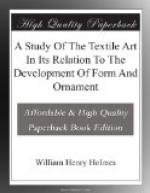House building, or architecture as it is called in the higher stages, is in primitive times to a great extent textile; as culture develops, other materials and other systems of construction are employed, and the resultant forms vary accordingly; but textile characters are especially strong and persistent in the matter of ornament, and survive all changes, howsoever complete. In a similar way other branches of art differentiated in material and function from the parent art inherit many characters of form and ornament conceived in the textile stage. It may be difficult to say with reference to any particular example of design that it had a textile origin, for there may be multiple origins to the same or to closely corresponding forms; but we may assert in a general way of the great body of geometric ornament that it owes something—if not its inspiration, its modes of expression—to the teachings of the textile system. This appears reasonable when we consider that the weaver’s art, as a medium of esthetic ideas, had precedence in time over nearly all competitors. Being first in the field it stood ready on the birth of new forms of art, whether directly related or not, to impose its characters upon them. What claim can architecture, sculpture, or ceramics have upon the decorative conceptions of the Digger Indians, or even upon those of the Zuni or Moki? The former have no architecture, sculpture, or ceramics; but their system of decoration, as we have seen, is highly developed. The Pueblo tribes at their best have barely reached the stage at which esthetic ideas are associated with building; yet classic art has not produced a set of geometric motives more chaste or varied. These examples of the development of high forms of decoration during the very early stages of the arts are not isolated. Others are observed in other countries, and it is probable that if we could lift the veil and peer into the far prehistoric stages of the world’s greatest cultures the same condition and order would be revealed. It is no doubt true that all of the shaping arts in the fullness of their development have given rise to decorative features peculiar to themselves; for construction, whether in stone, clay, wood, or metal, in their rigid conditions, exhibits characters unknown before, many of which tend to give rise to ornament. But this ornament is generally only applicable to the art in which it develops, and is not transferable by natural processes—as of a parent to its offspring—as are the esthetic features of the weaver’s art.
Besides the direct transmission of characters and forms as suggested in a preceding paragraph, there are many less direct but still efficacious methods of transfer by means of which various arts acquire textile decorative features, as will be seen by the following illustrations.




